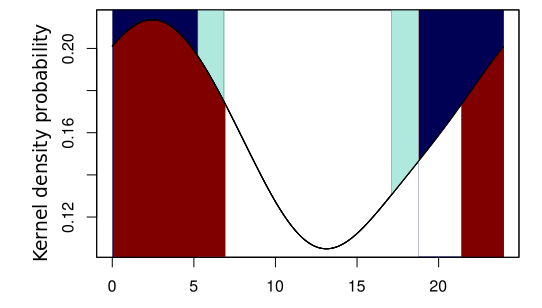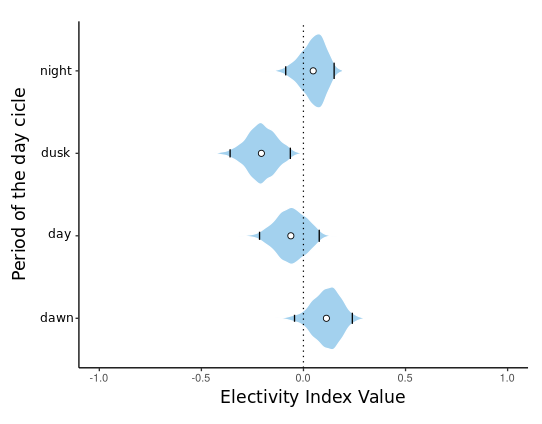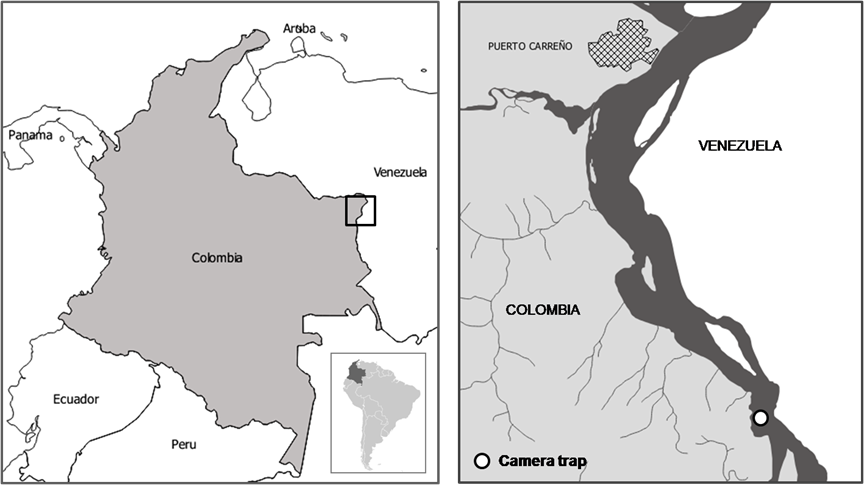IUCN/SSC Otter Specialist Group Bulletin

©IUCN/SCC Otter Specialist Group
Volume 37 Issue 3 (November 2020)
Citation: Garrote, G, Alvarez, A, Asensio, V, Castañeda, B, Marín, B, Bonilla, P and Trujillo, F (2020). Activity Patterns of the Neotropical Otter (Lontra longicaudis) in the River Orinoco (Colombia). IUCN Otter Spec. Group Bull. 37 (3): 158 - 162
Activity Patterns of the Neotropical Otter (Lontra longicaudis) in the River Orinoco (Colombia)
Germán Garrote1*, Antón Alvarez1, Victoria Asensio1, Beyker Castañeda2, Brayan Marín2, Patricia Bonilla1, and Fernando Trujillo2
1Instituto de Biología de la Conservación (IBiCo). c/ Neblí, 13. 28230. Madrid, Spain
2Fundación Omacha. Calle 84 No. 21 - 64 Barrio El Polo. Bogotá D.C. Colombia
* Corresponding author: email::gergarrote@gmail.com
(Received 16th October 2019, accepted 27th April 2020)
Abstract: The Neotropical otter (Lontra longicaudis), classified as Near Threatened, has the widest distribution of all South American species of the genus Lontra. Historically, this otter has always been considered to be a diurnal species despite the fact that only one study has ever investigated its activity cycles. Therefore, knowledge of the activity patterns of the Neotropical otter is still at best anecdotal. In this study, we describe the activity patterns of this otter in an area on the river Orinoco frequented by humans using records obtained by remote camera trapping. Our results seem to indicate that the Neotropical otter in our study area is mostly active at night and at dawn, which indicates that this species’ activity cycles are more flexible than once thought.Keywords: Llanos orientales, circadian activity, camera trap, circular statistics
INTRODUCTION
The activity patterns of most animals are related to circadian rhythms and periodic changes in environmental factors (Aschoff, 1966). Carnivores usually exhibit daily cycles of activity, which are probably determined by prey activity and feeding tactics (Zielinski, 1988; Lode, 1995). As well, some may change their activity patterns as a strategy to avoid interspecific competition (Alvarez et al., 2017) or coinciding with human activities (Riley et al., 2008).
The Neotropical otter (Lontra longicaudis), is classified as Near Threatened (Rheingantz and Trinca, 2015) and has the largest distribution of all South American Lontra species (Redford and Eisenberg, 1992). Nevertheless, critical data regarding aspects of its biology, demography, and behaviour are still lacking for many parts of its range (Rheingantz and Trinca, 2015).
Historically, the Neotropical otter has always been considered a diurnal species (Parera, 1993), although only one study has ever investigated its activity cycles (Rheingantz et al., 2016). The use of camera traps in two regions of Brazil, the Pantanal and the Atlantic Forest have revealed differing activity patterns in each area, this otter being diurnal in the former and nocturnal in the latter. Therefore, knowledge of the activity patterns of the Neotropical otter is at best anecdotal (Rheingantz et al., 2016). In our study, we aimed to describe the activity patterns of the Neotropical otter in an area frequented by humans along the river Orinoco in the Department of Vichada, Colombia.
METHODS
Study area
The study was carried out along the river Orinoco in the municipality of Puerto Carreño in the northeast of the department of Vichada (E Colombia; 6° 11 '16' 'N, 67° 28' 23 '' W: Fig. 1). There are two discernible seasons, dry (December-March) and rainy (April–November) (IGAC, 1996). This area is characterized by the presence of numerous rocky outcrops, which give rise to areas of rapids and backwaters. The Giant Otter (Pteronura brasiliensis) is present in the area and both species of otters use these rocky outcrops as sites for their latrines. Commercial and recreational fishing is frequent in the area.
Between 29 January and 28 February 2019, we placed one camera trap (Bushnell R Trophy Cam) opposite the entrance to a holt of a Neotropical otter, following the methodology used by Rheingantz et al. (2016). We used one-hour intervals as independent periods between photographic records (Di Bitetti et al., 2010; Leuchtenberger et al., 2014). The holt consisted of a cove between the rocks of an outcrop on an island in the middle of the river Orinoco.
Statistical analysis
We established a standardized circadian scale with sunrise and sunset times at 06:00 and 18:00, respectively. The raw time information of each record was rescaled to this standardized scale by interpolation based on sunrise and the sunset times at the site and the date of the record. We described activity patterns using circular kernel density estimations (Oliveira-Santos et al., 2013) that recognize the continuous circular nature of the data. We estimated activity using 50% isopleths.
We evaluated the otters’ activity during four periods in the diel cycle (dawn, day, dusk and night) using Ivlev’s Electivity Index (Ivlev, 1961). We defined dawn and dusk as the periods when the sun’s height is below -12° and +12° and measured availability as the proportion of the diel cycle covering each period. The use made by otters of each period was estimated as the proportion of the kernel activity density located within that period. We tested the hypothesis of period selection by otters by resampling (bootstrap with replacement) capture events 1,000 times using the same number of records as the original sample. We rejected the Electivity index selection when the zero value lay within the 2.5% and 97.5% quantiles of the distribution of the simulated Electivity index values. We ran all analyses on R using the tidyverse, circular and maptools packages.
RESULTS
We obtained 13 independent records from a sampling effort of 30 camera traps/days. Previous studies indicate that a minimum of 10 records is necessary to perform this analysis (Monterroso et al., 2014). The kernel density function (Fig. 2) has a unimodal distribution with the 50% kernel density probability corresponding to the night and dawn periods.

The results of the Electivity index values indicate that otters significantly avoid dusk (Fig. 3). Otters negatively selected the day but positively selected night and dawn, although these latter selections were not statistically significant.

DISCUSSION
Despite the relatively few photographs obtained, and the fact that we just sampled one holt, our results indicated that the Neotropical Otter in the study area concentrates its activity at night and dawn. This concurs with the findings obtained by Rheingantz et al. (2016) in the Atlantic forest. These authors point to intense human activity and synchronization with prey species that are mainly crepuscular or nocturnal as possible causes of the predominance of nocturnal activity. During the dry season, this stretch of the Orinoco River is frequented by fishermen that habitually camp out on its banks, sometimes with their families and dogs. Therefore, as in the Atlantic forest, human activity could be a factor driving the nocturnal activity pattern, this time of year, in our study area.
Other main factors that may influence a species’ activity patterns as the diet of the Neotropical otter and interspecific competition with the giant otters are unknown for the region and need to be investigated in order to either support or refute these hypotheses.
The results presented here must be treated with care due to the small sample size. Nevertheless, these data represent novel information about the activity patterns of the Neotropical Otter in the river Orinoco. As well as attempting to increase the number of activity records of the species, we should also aim to explore aspects such as the influence of anthropogenic activities, diet, foraging strategies related to prey activity, and interactions with the Giant Otter to identifying more clearly which factors modulate activity patterns in the Neotropical Otter in this region.
Acknowledgements: This study was funded by Fundación Barcelona Zoo and Ayuntamiento de Barcelona. We thank an anonymous reviewer who improved the manuscript.
REFERENCES
Álvarez, A., Garrote, G., Pérez de Ayala, R. (2017). Influencia del lince (Lynx pardinus) en los patrones de actividad circadiana del zorro (Vulpes vulpes). XIII Jornadas SECEM. Guadalajara. Spain.
Aschoff, J. (1966). Circadian Activity Pattern with Two Peaks. Ecology. 47, 657-662.
Di Bitetti, M.S., De Angelo, C.D., Di Blanco, Y.E. Paviolo, A. (2010). Niche partitioning and species coexistence in a Neotropical felid assemblage. Acta Oecol. 36, 403–412.
Ivlev, V.S. (1961). Experimental ecology of the feeding of fishes. New Haven: Yale University Press.
Leuchtenberger, C., Zucco, C.A., Ribas, C., Magnusson, W., Mourão, M. (2014). Activity patterns of giant otters recorded by telemetry and camera traps, Ethol. Ecol. Evol. 26, 19-28.
Lode T. (1995). Activity pattern of polectas Mustela putorius L. in relation to food habits and prey activity. Ethology, 100: 295–308
Monterroso, P., Alves, P.C., Ferreras, P. (2014). Plasticity in circadian activity patterns of mesocarnivores in Southwestern Europe: implications for species coexistence. Behav. Ecol. Sociobiol. 68,: 1403–1417.
Oliveira-Santos, L. G. R., Zucco, C. A., Agostinelli, C. (2013). Using conditional circular kernel density functions to test hypotheses on animal circadian activity. Anim. Behav., 85, 269-280.
Parera, A. (1993). The neotropical river otter Lutra longicaudis in Iberá lagoon, Argentina. International Union for the Conservation of Nature. IUCN Otter Spec. Group Bull. 8, 13- 16.
Redford, K.H., Eisenberg, J.F. (1992). Mammals of the Neotropics: the Southern Cone. Chile, Argentina, Uruguay, Paraguay. The University of Chicago Press.
Rheingantz, M.L., Trinca, C.S. (2015). Lontra longicaudis. The IUCN Red List of Threatened Species 2015: e.T12304A21937379. http://dx.doi.org/10.2305/IUCN.UK.2015-2.RLTS.T12304A21937379.en. Downloaded on 19 March 2019.
Rheingantz, M., Leuchtenberger, C., Zucco, C., Fernandez, F. (2016). Differences in activity patterns of the Neotropical otter Lontra longicaudis between rivers of two Brazilian ecoregions. J. Trop. Ecol. 32, 170-174.
Riley, S.P., Sauvajot, R.M., Fuller, T.K., York, E.C., Kamradt, D.A., Bromley, C. Wayne, R.K. (2008). Effects of urbanization and habitat fragmentation on bobcats and coyotes in Southern California. Cons. Biol., 17, 566–576.
Zielinski W.J. (1988). The influence of daily variation in foraging cost on the activity of small carnivores. Anim. Behav. 36, 239-24.
Résumé: Modèles d’Activité de la Loutre à Longue Queue (Lontra longicaudis) sur la Riviere Orénoque (Colombie)
La loutre à longue queue (Lontra longicaudis), répertoriée comme quasi menacée, a la distribution la plus large de toutes les espèces sud-américaines du genre Lontra. Historiquement, cette loutre a toujours été considérée comme une espèce diurne en dépit du fait qu’une seule étude ait investigué ses cycles d'activité. Par conséquent, la connaissance des modèles d'activité de la loutre à longue queue est encore au mieux anecdotique. Dans cette étude, nous décrivons, à l'aide d'enregistrements à distance obtenus par des pièges photos, les schémas d'activité de cette loutre dans un secteur de la rivière Orénoque fréquenté par l'homme. Nos résultats semblent indiquer que la loutre à longue queue de notre zone d'étude est principalement active durant la nuit et à l'aube, ce qui indique que les cycles d'activité de cette espèce sont plus flexibles qu'on ne le pensait..
Revenez au dessus
Resumen: Patrones de Actividad de la Nutria Neotropical (Lontra longicaudis) en el Río Orinoco Colombia
La nutria neotropical (Lontra longicaudis), clasificada como Casi Amenazada, tiene la distribución más amplia de todas las especies sudamericanas del género Lontra. Históricamente, esta nutria siempre se ha considerado una especie diurna a pesar de que solo un estudio ha investigado sus ciclos de actividad. Por lo tanto, el conocimiento de los patrones de actividad de la nutria neotropical sigue siendo, en el mejor de los casos, anecdótico. En este estudio, mediante datos obtenidos con cámaras trampa, describimos los patrones de actividad de esta nutria en un área del río Orinoco frecuentada por humanos. Nuestros resultados parecen indicar que la nutria neotropical en nuestra área de estudio está principalmente activa en la noche y al amanecer, lo que indica que los ciclos de actividad de esta especie son más flexibles de lo que se pensaba.
Vuelva a la tapa

